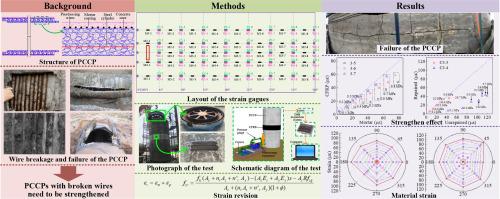Tunnelling and Underground Space Technology ( IF 6.7 ) Pub Date : 2023-02-15 , DOI: 10.1016/j.tust.2023.105032 Kejie Zhai , Hongyuan Fang , Bin Li , Chengchao Guo , Kangjian Yang , Xueming Du , Mingrui Du , Niannian Wang

|
The prestressed concrete cylinder pipe (PCCP) has been used widely in hydraulic engineering. However, due to hydrogen embrittlement and corrosion, the prestressing wires in PCCP can break and cause pipe failure. In this study, a retrofitting technique of using externally bonded carbon fiber reinforced polymer (CFRP) to repair PCCP was proposed. The technique is particularly useful when shutting down water is not possible. The proposed strategy was evaluated by using a full-scale PCCP with a 2.8 m inside diameter loaded with internal water pressure. First, the PCCP strains before and after repair were compared under different internal pressures. In the presence of CFRP, the strains near the broken wires significantly decreased under the same internal pressure, and the carrying capacity of the PCCP increased. PCCPs with 13 %, 15 %, and 18 % wire breakage ratios were then evaluated and compared. The strain in each material increased with increasing wire breakage ratio, and the maximum strain in CFRP was observed at the location of wire breakage. Considering the PCCP with 18 % wire breakage ratio, the section 2300 mm from the pipe end was in the linear state under an internal pressure of 0–0.9 MPa, and the PCCP reached its serviceability and elastic limit states when the internal pressure increased to about 1.0 MPa and 1.2 MPa, respectively. Finally, when the internal water pressure was increased to 1.27 MPa, which was higher than the internal design pressure of 1.12 MPa, the PCCP failed due to the rupture of CFRP.
中文翻译:

CFRP加固预应力混凝土筒管断丝破坏试验
预应力混凝土筒管(PCCP)在水利工程中得到了广泛的应用。然而,由于氢脆和腐蚀,PCCP 中的预应力线会断裂并导致管道失效。在这项研究中,提出了一种使用外部粘合碳纤维增强聚合物(CFRP)修复PCCP的改造技术。当无法关闭水时,该技术特别有用。通过使用内径为 2.8 m 并加载内部水压的全尺寸 PCCP 对所提出的策略进行了评估。首先,比较了不同内压下修复前后的 PCCP 菌株。在CFRP的存在下,相同内压下断丝附近的应变显着降低,PCCP的承载能力增加。PCCPs 13 %, 15 %, 然后评估和比较 18% 的断线率。每种材料的应变随着断线率的增加而增加,并且在断线位置观察到 CFRP 的最大应变。考虑断丝率为18%的PCCP,在内压0~0.9MPa下,距离管端2300mm的截面呈直线状态,当内压增加到约1000MPa时,PCCP达到使用性能和弹性极限状态。分别为 1.0 MPa 和 1.2 MPa。最后,当内部水压增加到 1.27 MPa,高于内部设计压力 1.12 MPa 时,PCCP 由于 CFRP 破裂而失效。并且在断线处观察到 CFRP 的最大应变。考虑断丝率为18%的PCCP,在内压0~0.9MPa下,距离管端2300mm的截面呈直线状态,当内压增加到约1000MPa时,PCCP达到使用性能和弹性极限状态。分别为 1.0 MPa 和 1.2 MPa。最后,当内部水压增加到 1.27 MPa,高于内部设计压力 1.12 MPa 时,PCCP 由于 CFRP 破裂而失效。并且在断线处观察到 CFRP 的最大应变。考虑断丝率为18%的PCCP,在内压0~0.9MPa下,距离管端2300mm的截面呈直线状态,当内压增加到约1000MPa时,PCCP达到使用性能和弹性极限状态。分别为 1.0 MPa 和 1.2 MPa。最后,当内部水压增加到 1.27 MPa,高于内部设计压力 1.12 MPa 时,PCCP 由于 CFRP 破裂而失效。分别为 0 MPa 和 1.2 MPa。最后,当内部水压增加到 1.27 MPa,高于内部设计压力 1.12 MPa 时,PCCP 由于 CFRP 破裂而失效。分别为 0 MPa 和 1.2 MPa。最后,当内部水压增加到 1.27 MPa,高于内部设计压力 1.12 MPa 时,PCCP 由于 CFRP 破裂而失效。











































 京公网安备 11010802027423号
京公网安备 11010802027423号